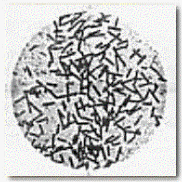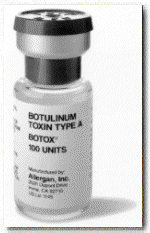Botulinum toxins are essentially neurotoxins, and are often found in poorly preserved food, or more rarely in flesh wounds. The clinical effects of Botulinum Toxins have been known since 1897, when Van Ermengem (Belgium) found a Toxin produced by the bacteria Clostridium Botulinum in the blood of a patient with Botulism. Later there was found to be seven distinct types of the toxin known, these are denoted by A through G.

Above: The Clostridium Botulinum bacteria responsible for the production of Botulinum Toxins.
These toxins have been the subject of much research and in 1949 the toxic mechanism of Botulinum Toxins was found to be their blocking action at the neuro-muscular junction.
The toxins have proven to have wide variety of uses. It was in 1981 that the value of Botulinum Toxins in medicine was first realized when the toxin was used to successfully treat Strabismus (Crossed eyes) in humans. Perhaps most surprisingly the Toxin has been found to have applications in the field of cosmetics.

Above: One type of Botulinum Toxin (A) has a wide variety of uses in medicine, and also uses in cosmetic medicine.
Their high toxicity means that Botulinum Toxins present themselves for use in Biochemical weapons, unfortunately their relative ease of production and low cost poses a real terrorism threat.
This web-site serves
as a brief introduction into what is undoubtedly a fascinating set
of macromolecules. There is a brief quiz relating
to the information on this web-site. Also included are a set of links
to web-sites that may be consulted for further information on the
topic.